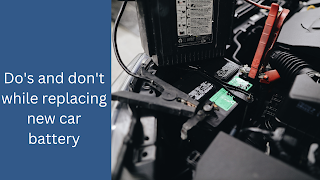Do's and don't while replacing new car battery
Here are some do's and don'ts for replacing a car battery:
Do's:
Before beginning, consult your vehicle's owner's manual
to ensure that you have the correct type of battery and that you understand the
steps involved in removing and replacing it.
·
Make
sure your vehicle is turned off and the engine is cool before attempting to
replace the battery.
·
Wear
protective gloves and eye wear to protect yourself from battery acid.
·
Carefully
disconnect the negative cable from the old battery first, and then the positive
cable. This will help prevent short circuits and sparks.
·
Be
gentle when removing the old battery to avoid damaging the battery tray or
other nearby components.
·
Clean
the battery tray and cable terminals with a mixture of baking soda and water to
remove any dirt or corrosion.
·
Install
the new battery, making sure that it is securely fastened to the battery tray
and that the cable terminals are properly attached.
·
Once
the new battery is installed, start the engine and check that all electrical
components are functioning properly.
Don’ts:
·
Don't
attempt to replace the battery if you are unsure of how to do so or if you
don't have the correct tools.
·
Don't
touch the terminals of the old battery with your bare hands, as the acid can
cause burns.
·
Don't
allow the cables to touch each other or any metal surfaces when removing or
installing the battery.
·
Don't
install the new battery upside down, as this can cause damage to the vehicle's
electrical system.
·
Don't
use an old or defective battery, as this can lead to poor performance and
potential damage to your vehicle.
Why it is necessary to replace new car battery?
There are a few
reasons why it may be necessary to replace the battery in a car:
Age: Car batteries
have a limited lifespan and will eventually need to be replaced. The average
lifespan of a car battery is 3-5 years, but this can vary depending on the
quality of the battery and the conditions in which it is used.
Performance: As a
car battery ages, it may not hold a charge as well as it used to. This can lead
to problems starting the car, particularly in cold weather. Replacing the
battery can improve the car's performance and reliability.
Damage: A car
battery can become damaged due to a variety of factors, including overcharging,
physical damage, and corrosion. If the battery is damaged, it may need to be
replaced in order to ensure that the car runs properly.
Overall, replacing
a car battery is important to maintain the reliability and performance of a
car. It is typically recommended to replace the battery before it fails
completely to avoid being stranded on the side of the road.




Comments
Post a Comment